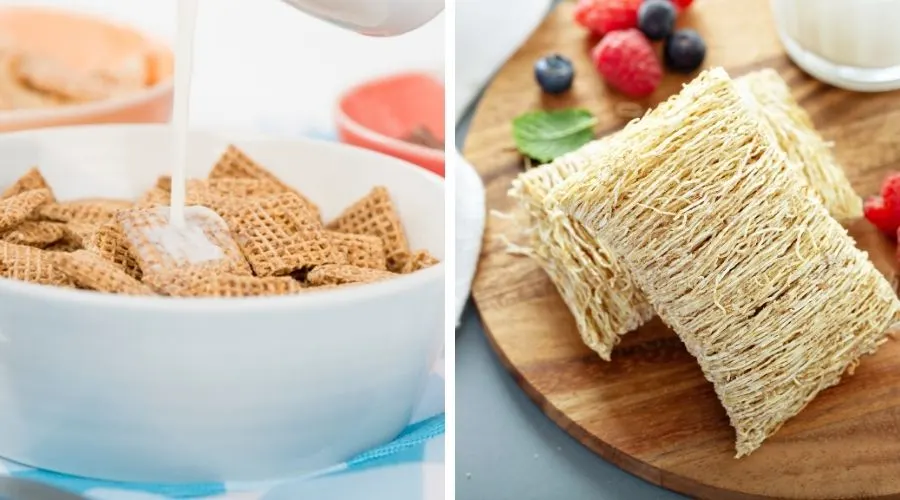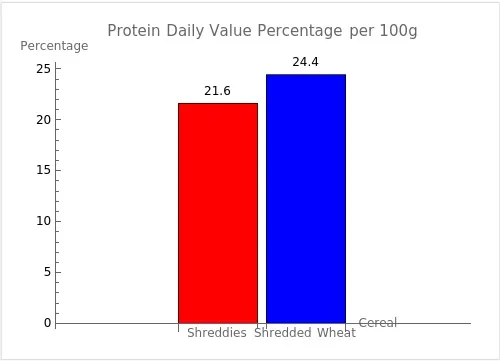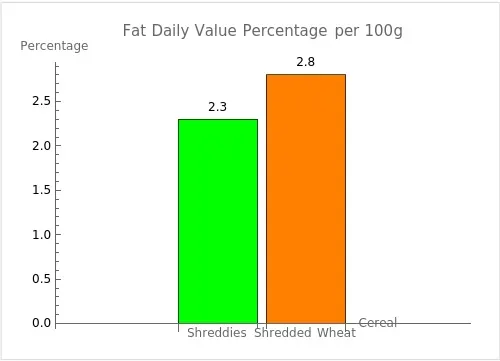When you think of healthier breakfast cereals, both Shreddies and Shredded Wheat would probably be high up on the list as a better option than some other cereal choices – but is one better than the other?
In this article, I’ll be comparing Nestlé Shreddies and Shredded Wheat head-to-head to find out which is best in various categories, including nutrition and cost.
Also, you can take part in our voting poll to tell us which you like best and help us find out which is the best cereal for flavor.
Also in This Article
In a hurry, or looking for something specific? Use the links below to jump to the relevant section:
Ingredients Comparision
The table below shows the ingredients of Nestlé Shreddies and Shredded Wheat so you can compare the two.
Both types of cereal are made from Whole Grain Wheat and is, in fact, Shredded Wheat’s only ingredient. Shreddies have more ingredients, including sugar and added vitamins and minerals.
| Nestlé Original Shreddies Ingredients | Nestlé Shredded Wheat Ingredients |
| Whole Grain Wheat (96%), Sugar, Invert Sugar Syrup, Barley Malt Extract, Salt, Molasses, Vitamins, and Minerals (Niacin, Iron, Pantothenic Acid, Folic Acid, Vitamin B6, Riboflavin) | Whole Grain Wheat (100%) |

Shreddies Vs. Shredded Wheat Nutritional Comparison
Starting with the nutritional comparison, from calories to vitamins and minerals. For information, the cereals will be compared on a weight-for-weight basis (per 100g) to keep the comparison accurate and fair.
Please note, a recommended serving of Shreddies is 40g, whereas a recommended serving of Shredded Wheat is 45g; although the weights are different, I’ve also included data per serving for information.
Best for Calorie Content
Moving onto the calorie comparison, both kinds of cereal contain a similar amount of calories per weight, but the cereal with the least calories is Shredded Wheat which contains 360kcal per 100g, compared to Shreddies, which contain 364kcal.
It might appear that Shredded Wheat contain more calories than Shreddies per serving, but this is because a serving of Shredded Wheat weighs more.
| Cereal Type | Calories Per 100g | Calories Per Serving |
| Nestlé Original Shreddies | 364kcal | 145kcal (per 40g serving) |
| Nestlé Shredded Wheat | 360kcal | 162kcal (per 45g serving) |
Best for Carbohydrate Content
Neither Shreddies nor Shredded Wheat can be classed as low-carbohydrate breakfast cereals, but if this is something you’re tracking, Shredded Wheat are the lower-carb option with 3.1g less carbs per 100g.
| Cereal Type | Carbohydrates Per 100g | Carbohydrates Per Serving |
| Nestlé Original Shreddies | 70.1g | 28g (per 40g serving) |
| Nestlé Shredded Wheat | 67g | 30g (per 45g serving) |
Best for Sugar Content
When it comes to sugar content between Shreddies and Shredded Wheat, Shredded Wheat is the best option and hardly contains any sugar with only 0.3g per serving, compared to Shreddies which contain 5g of sugar per serving.
This is because Shreddies have added sugar, whereas Shedded Wheat only contains one ingredient (whole-grain wheat), which means any sugars are natural.
| Cereal Type | Sugars Per 100g | Sugars Per Serving |
| Nestlé Original Shreddies | 12.5g | 5g (per 40g serving) |
| Nestlé Shredded Wheat | 0.7g | 0.3g (per 45g serving) |
Best for Protein Content
If protein content is important to you when choosing a breakfast cereal, then Shredded Wheat is the best option for you with 1.4g more protein per 100g of cereal when compared to Shreddies.
| Cereal Type | Protein Per 100g | Protein Per Serving |
| Nestlé Original Shreddies | 10.8g | 4.3g (per 40g serving) |
| Nestlé Shredded Wheat | 12.2g | 5.5g (per 45g serving) |

- Shreddies: The daily value percentage of protein is approximately 21.6%.
- Shredded Wheat: The daily value percentage of protein is approximately 24.4%.
The recommended daily intake of protein for an average adult on a 2,000 calorie diet is about 50 grams. This graph shows how each cereal contributes to this daily requirement.
Best for Fat Content
Shreddies and Shredded Wheat are both very low in fat breakfast options and the fat there is will be natural fat from the whole-grain and not a bad fat.
Between the two, Shreddies are slightly lower in fat than Shredded Wheat, however the values are nominal.
| Cereal Type | Fat Per 100g | Saturated Fat per 100g |
| Nestlé Original Shreddies | 1.8g | 0.3g |
| Nestlé Shredded Wheat | 2.2g | 1g |

- Shreddies: The daily value percentage of fat is approximately 2.3%.
- Shredded Wheat: The daily value percentage of fat is approximately 2.8%.
The recommended daily intake of fat for an average adult on a 2,000 calorie diet is about 78 grams. This graph shows how each cereal contributes to this daily requirement in terms of fat content.
Best for Fiber Content
Most people choose a whole-grain based cereal like Shreddies or Shredded Wheat because they’re higher fiber options when compared to other breakfast cereals.
Shreddies and Shredded Wheat are both very similar when it comes to fiber content, but Shreddied contain slightly more (0.1g) more fiber per 100g than Shredded Wheat. It’s worth noting that this is a nominal amount and both kinds of cereal are high-fiber options.
| Cereal Type | Dietary Fibre Per 100g | Dietary Fibre per Serving |
| Nestlé Original Shreddies | 12.3g | 4.9g (per 40g serving) |
| Nestlé Shredded Wheat | 12.2g | 5.5g (per 45g serving) |
Best for Sodium/Salt Content
When it comes to salt content, Shredded Wheat is lowest in salt with only 0.05g per 100g of cereal.
Shredded Wheat has no added salt, whereas Shreddies have salt added to the ingredients, although they’re not high in salt either.
| Cereal Type | Salt/Sodium Per 100g | Salt per Serving |
| Nestlé Original Shreddies | 0.72g | 0.29g (per 40g serving) |
| Nestlé Shredded Wheat | 0.05g | 0.02g (per 45g serving) |
Best for Vitamins/Minerals
Shreddies are a fortified cereal which means certain vitamins and minerals are added to the ingredients, whereas Shredded Wheat only has one simple ingredient.
I’ve been unable to compare the cereals in this category due to a lack of vitamin & mineral data for Nestlé Shredded Wheat.
For information, the table below shows the vitamins and minerals which are added to Shreddies:
| Vitamin/Mineral Type | Nestlé Original Shreddies | Nestlé Shredded Wheat |
| Riboflavin | 0.36mg / 26% | No data |
| Niacin | 4.3mg / 27% | No data |
| Vitamin B6 | 0.40mg / 28% | No data |
| Folic Acid | 44mcg / 22% | No data |
| Iron | 3mg / 22% | No data |
*mcg = microgram (1000th of a milligram) / mg = milligram (1000th of a gram)
Best for Flavor/Texture
Because the taste of food is subjective and varies from person to person, this is not something I can judge without a poll across a range of voters.
You can help to decide the winner of this category by voting for your favorite in the poll below and once you vote you’ll be able to see the public favorite so far.
Best for Price
Because Shredded Wheat and Shreddies are sold in different pack sizes, I’ll be comparing the cost per 100g of cereal to keep things fair.
At the time of writing this article, the average cost of Nestlé Shreddies in the UK are £0.42 per 100g and the cost of Shredded Wheat are £0.40.
Based on this information, Shredded Wheat are slightly cheaper than Shreddies, although there isn’t much difference in price between the two.
Overall Winner
All categories have now been compared and the winner of most categories for nutrition and cost is Shredded Wheat which won in best for calories, carbs, sugar, protein, salt content, and price.
It’s important to note that Shreddies are still a great option and were only slightly behind in most categories and surprisingly they’re slightly higher in fiber too.
Which is best for you, depends on what is most important to you and your diet, but hopefully, you can use the information in this article to make an informed breakfast cereal choice.
| Comparison Category | Winner (Shreddies or Shredded Wheat) |
| Best for Calorie Content | Shredded Wheat |
| Best for Carbohydrate Content | Shredded Wheat |
| Best for Sugar Content | Shredded Wheat |
| Best for Protein Content | Shredded Wheat |
| Best for Fat Content | Shreddies |
| Best for Fiber Content | Shreddies |
| Best for Salt Content | Shredded Wheat |
| Best for Vitamins/Minerals | Unable to compare |
| Best for Price | Shredded Wheat |
| Overall Winner | Shredded Wheat |
Related Articles
I hope this article has helped you to find the information you were looking for; you might also find the following articles helpful too:
All-Bran Vs. Bran Flakes (Which is Best?)
Frosties Vs. Corn Flakes (Which is Best)
Corn Flakes Vs. Frosted Flakes (Which is Best?)
References Used for this Article
To ensure the nutritional information used in this article is accurate, I have used data from the manufacturer; the links below contain the source information:
